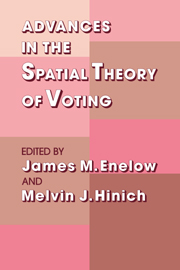Book contents
- Frontmatter
- Contents
- Foreword
- ADVANCES IN THE SPATIAL THEORY OF VOTING
- 1 Introduction
- 2 Multiparty Competition, Entry, and Entry Deterrence in Spatial Models of Elections
- 3 Heresthetic and Rhetoric in the Spatial Model
- 4 Spatial Strategies When Candidates Have Policy Preferences
- 5 A Decade of Experimental Research on Spatial Models of Elections and Committees
- 6 Candidate Uncertainty and Electoral Equilibria
- 7 The Theory of Predictive Mappings
- 8 Multicandidate Spatial Competition
- 9 The Setter Model
- Author Index
- Subject Index
4 - Spatial Strategies When Candidates Have Policy Preferences
Published online by Cambridge University Press: 05 March 2012
- Frontmatter
- Contents
- Foreword
- ADVANCES IN THE SPATIAL THEORY OF VOTING
- 1 Introduction
- 2 Multiparty Competition, Entry, and Entry Deterrence in Spatial Models of Elections
- 3 Heresthetic and Rhetoric in the Spatial Model
- 4 Spatial Strategies When Candidates Have Policy Preferences
- 5 A Decade of Experimental Research on Spatial Models of Elections and Committees
- 6 Candidate Uncertainty and Electoral Equilibria
- 7 The Theory of Predictive Mappings
- 8 Multicandidate Spatial Competition
- 9 The Setter Model
- Author Index
- Subject Index
Summary
INTRODUCTION
In An Economic Theory of Democracy, Anthony Downs characterized a political party as a team whose goal is to win the election. Although such an assumption concerning political parties is a reasonable first step, it is open to two important criticisms. The party may not be a team, and the goal of the party leaders may not be to win the election. Consider the latter criticism. It would be strange if the voters were interested in policy and not the members of the political party, especially so because government policy is a public good shared by all. Even if candidates were interested only in winning, the need to win election primaries would force the candidates to adopt positions more in line with the concerns of the median voter of the political party (or, more generally, of their constituencies). Since the party's median voter wants to maximize his/her expected utility from the election outcome, the political party's candidate would then adopt a position that maximized the party's median voter's expected utility from policy outcome. Treating the political party as a team also ignores the principal/agent problems that arise when monitoring is imperfect or when agreements are not completely enforceable. The winning candidate might enact policies that are more consistent with his/her own desires than those of the voters. In a nutshell, winning may be a means to enact policy, rather than policy being a means toward winning.
Here, we will assume that candidates maximize expected policy implementation. This approach not only has more realistic assumptions but, as will be shown in the following pages, also has a much richer set of empirical predictions.
- Type
- Chapter
- Information
- Advances in the Spatial Theory of Voting , pp. 66 - 98Publisher: Cambridge University PressPrint publication year: 1990
- 30
- Cited by



